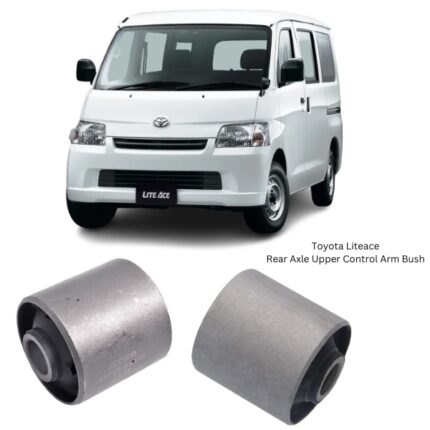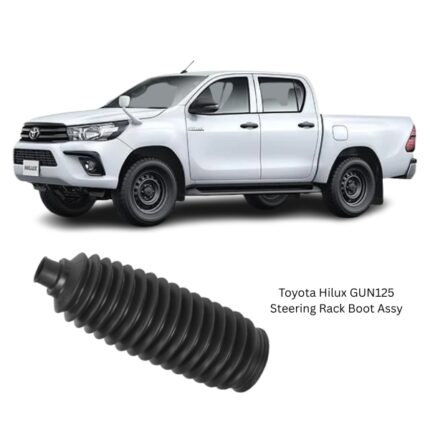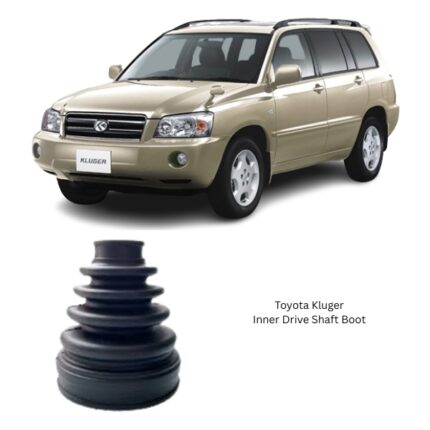Get Toyota Kluger Inner Drive Shaft Boot 43448-28051 in Kenya
The Inner Drive Shaft Boot, also referred to as the Inner CV Boot (Constant Velocity boot), is a vital component of a vehicle’s drivetrain system. Though modest in size, it plays a crucial role in protecting the constant velocity joint on the inner side of the drive shaft—ensuring smooth and reliable power delivery from the transmission to the wheels. This flexible, rubber-like covering surrounds the inner CV joint and is specifically engineered to shield it from contaminants while retaining grease necessary for proper lubrication.
By serving as the first line of defense for the inner CV joint, the Inner Drive Shaft Boot contributes significantly to drivetrain efficiency, vehicle performance, and component longevity. A failure in this part can lead to a loss of lubrication, contamination of the joint, accelerated wear, and eventually, drive shaft or CV joint failure.
Function and Purpose
The primary function of the Inner Drive Shaft Boot is to encase and protect the inner CV joint from harmful elements while ensuring it remains well-lubricated. Located closest to the transmission or differential, the inner CV joint compensates for changes in axle length during suspension movement and plays a vital role in torque delivery.
Key Functions of the Inner CV Boot:
-
Containment of Lubricant
The boot is packed with high-performance grease that ensures smooth joint operation. The boot prevents the lubricant from escaping during joint movement. -
Contaminant Barrier
Protects the CV joint from exposure to water, dust, dirt, sand, and road salt, all of which can degrade the joint’s internal surfaces. -
Flexibility for Movement
Expands and contracts with the motion of the joint as the suspension travels up and down, allowing full range of movement without restricting axle articulation. -
Preservation of Joint Life
By maintaining a sealed and clean environment, it helps prolong the functional life of the inner CV joint and, by extension, the drive shaft.
Design and Construction
The Inner Drive Shaft Boot is engineered with elasticity, durability, and resistance to environmental and mechanical stress in mind. Its design accommodates the demanding conditions of rotation, articulation, and exposure to road debris.
Typical Structure:
-
Outer Collar (Large End)
Fits over the CV joint housing and is secured using a stainless steel clamp or band. -
Inner Collar (Small End)
Attaches to the axle shaft and is also secured with a clamp, ensuring no slippage or leakage during operation. -
Bellows or Corrugations
The flexible middle section allows the boot to compress and extend as the suspension travels or the axle rotates. These folds ensure that the boot can move freely without stretching the material too thin.
Material Composition:
-
Neoprene Rubber
Commonly used due to its resistance to oil, heat, ozone, and road chemicals. Offers good flexibility and long service life. -
Thermoplastic Elastomers (TPE)
Lightweight and more rigid than rubber, often used in modern vehicles for improved resistance to cracking and environmental degradation. -
Silicone (in some applications)
Used in high-temperature or performance applications due to superior flexibility and thermal tolerance.
The material must maintain its structural integrity under a wide range of temperatures, withstand repetitive stretching, and resist tearing or puncturing from road debris.
Performance Characteristics
The Inner Drive Shaft Boot is critical in ensuring that the drivetrain operates smoothly and efficiently. A high-quality boot will:
-
Maintain a Tight Seal
Prevent grease leakage and block out moisture, dirt, and contaminants even under constant movement. -
Withstand Temperature Extremes
Perform consistently in both high-heat engine compartments and cold-weather climates. -
Resist Abrasion and Impact
Withstand debris and stones thrown up from the road without tearing or cracking. -
Support Long Service Intervals
Durable construction means fewer replacements, reduced downtime, and lower maintenance costs.
Signs of Wear or Failure
Because the inner drive shaft boot operates in a harsh environment and is subject to constant movement, it is prone to wear over time. If left unaddressed, a failing boot can lead to complete CV joint failure.
Common Symptoms of a Worn or Damaged Inner CV Boot:
-
Grease Leaks
Visible grease splatter around the inner wheel well or underbody is a clear sign that the boot has ruptured or is leaking. -
Cracks or Splits in the Boot
Upon visual inspection, cracks in the boot’s bellows or ends indicate aging rubber or exposure to heat and elements. -
Clicking or Popping Sounds
Especially during sharp turns or acceleration. While more typical of outer CV joint failure, advanced wear on the inner joint due to contamination can produce noise as well. -
Vibration During Acceleration
Damaged inner CV joints may cause noticeable vibration due to inconsistent torque delivery, often felt through the floorboard or steering wheel. -
Contaminated CV Joint
Water or dirt inside the boot often results in rust or accelerated internal wear, usually discovered during inspection or service.
Replacement and Installation
Replacing the Inner Drive Shaft Boot is a detailed task that involves partial disassembly of the drive shaft. It’s a preventive repair often done when a torn or cracked boot is discovered before the CV joint itself fails.
General Replacement Procedure:
-
Lift and Secure the Vehicle
Ensure safe access to the drive shaft. -
Remove the Axle Shaft
The axle must be detached from the differential or transmission and possibly from the wheel hub. -
Disassemble the CV Joint (if necessary)
Carefully disassemble the CV joint to access the boot area. -
Clean and Repack Grease
Clean the joint thoroughly and repack it with the specified high-temperature grease. -
Install New Boot
Slide the new boot over the shaft, clamp both ends securely, and reassemble the axle. -
Reinstall the Axle and Recheck
Ensure all bolts are torqued to spec, and confirm that the boot is seated correctly without binding.
Timely boot replacement can prevent the need for more expensive repairs involving the CV joint or complete axle assembly.
Maintenance and Inspection Tips
-
Visual Inspection: During regular maintenance or tire rotations, inspect the inner boots for cracks, grease leaks, or loose clamps.
-
Listen for Changes: Unusual noises or new vibrations may suggest a boot has failed and allowed contamination into the joint.
-
Preventive Care: Replacing a boot at the first sign of damage can save the CV joint from premature failure.
Advantages of Timely Replacement
-
Preserves CV Joint Lifespan
Prevents contamination and loss of grease that cause internal wear. -
Avoids Costly Repairs
A boot is significantly cheaper than replacing an entire axle or CV joint. -
Maintains Drivetrain Performance
Keeps torque delivery smooth and uninterrupted. -
Improves Safety
Prevents potential axle lockup or separation from joint failure.
Follow us on Facebook for more parts.





Reviews
Clear filtersThere are no reviews yet.